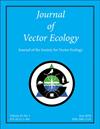鹿的补充喂养减少蜱的丰度在密西西比州,美国
IF 1.3
3区 农林科学
Q2 ENTOMOLOGY
引用次数: 0
摘要
摘要:先前对野生动物诱饵和喂食的研究发现,野生动物的栖息地和浓度在当地范围内(例如数百米)发生了变化。由于栖息地和宿主密度的变化会影响蜱虫,喂养野生动物可能会导致蜱虫和蜱传疾病生态的变化。我们量化了2019年5月至2020年8月期间,在79对有和没有喂食鹿的地点,喂食鹿对蜱虫和蜱传疾病的影响。在局部范围内,我们捕获的成人数量减少了0.4(p0.13)。鹿的补充喂养似乎会影响蜱虫,可能是由于蜱虫栖息地的减少和饲养者周围野生动物的使用增加。我们的研究结果表明,喂食并不会导致埃立克氏体或立克次体细菌在美洲A.americanum体内的流行率增加。本文章由计算机程序翻译,如有差异,请以英文原文为准。
Supplemental feeding of deer reduces tick abundance in Mississippi, U.S.A.
ABSTRACT: Prior research on baiting and feeding of wildlife found changes in habitat and the concentration of wildlife on a local scale (e.g., hundreds of meters). Since changes in habitat and host density affect ticks, feeding wildlife may lead to changes in tick and tick-borne disease ecology. We quantified the effect of feeding deer on ticks and tick-borne diseases at 79 pairs of sites with and without deer feeders during May-August of 2019 and 2020. We captured 0.4 fewer adult (p<0.05) and 1.2 fewer nymphal ticks (p=0.01) at feeder sites. This effect intensified over time with one fewer tick trapped at old feeders (≥5 years) compared to new feeders (<5 years, p<0.05). Greater daily wildlife visitation rates (p<0.001) may have allowed questing ticks to encounter hosts more readily. Most collected ticks were Amblyomma americanum (92.8%), a vector of Ehrlichia and Rickettsia pathogens, though prevalence of these pathogens did not differ (p>0.13) at a local scale. Supplemental deer feeding appears to influence ticks, possibly due to decreased tick habitat and increased wildlife use around feeders. Our findings indicate feeding does not lead to increased prevalence of Ehrlichia or Rickettsia bacteria within A. americanum locally.
求助全文
通过发布文献求助,成功后即可免费获取论文全文。
去求助
来源期刊

Journal of Vector Ecology
生物-昆虫学
CiteScore
2.60
自引率
5.90%
发文量
31
审稿时长
6-12 weeks
期刊介绍:
The Journal of Vector Ecology is an international journal published by the Society for Vector Ecology. It is concerned with all aspects of the biology, ecology, and control of arthropod and vertebrate vectors and the interrelationships between the vectors and the agents of disease that they transmit. The journal publishes original research articles and scientific notes, as well as comprehensive reviews of vector biology based on presentations at Society meetings. All papers are reviewed by at least two qualified scientists who recommend their suitability for publication. Acceptance of manuscripts is based on their scientific merit and is the final decision of the editor, but these decisions may be appealed to the editorial board. The journal began publishing in 1974 and now publishes on-line only.
 求助内容:
求助内容: 应助结果提醒方式:
应助结果提醒方式:


